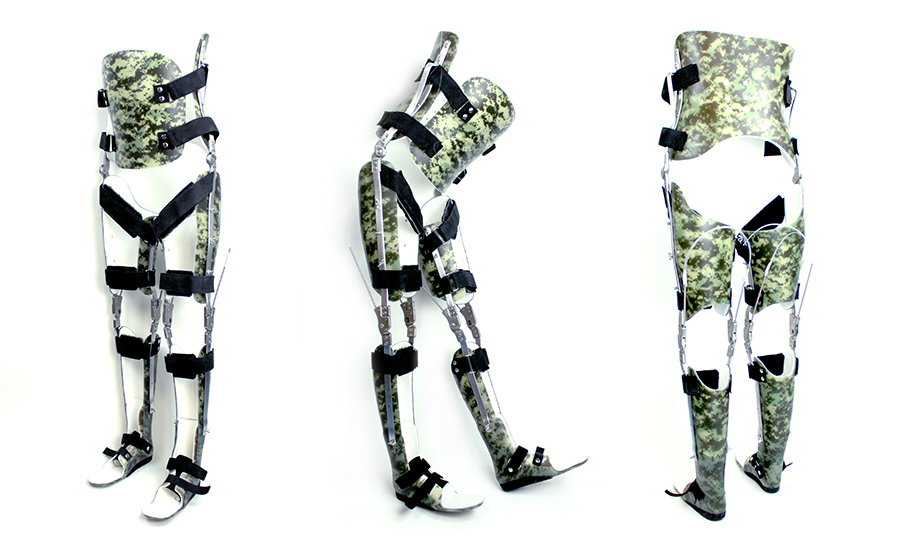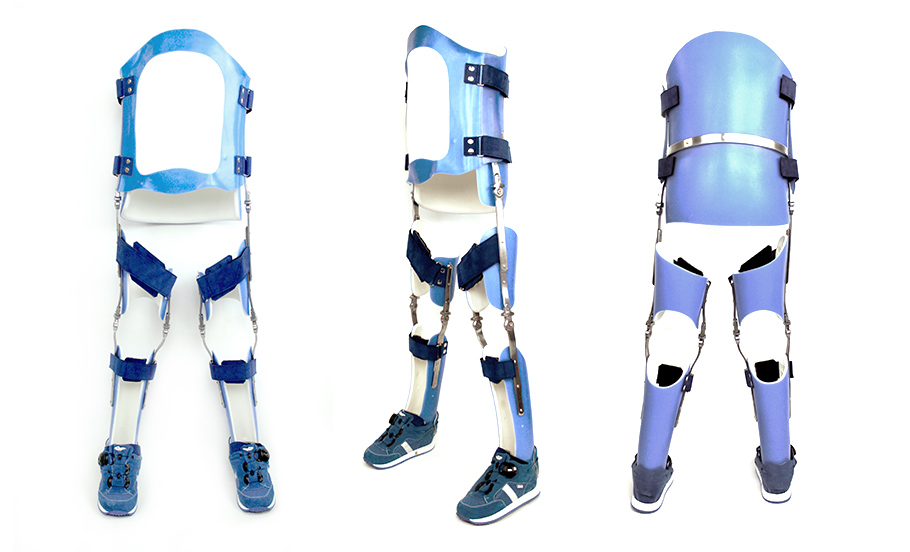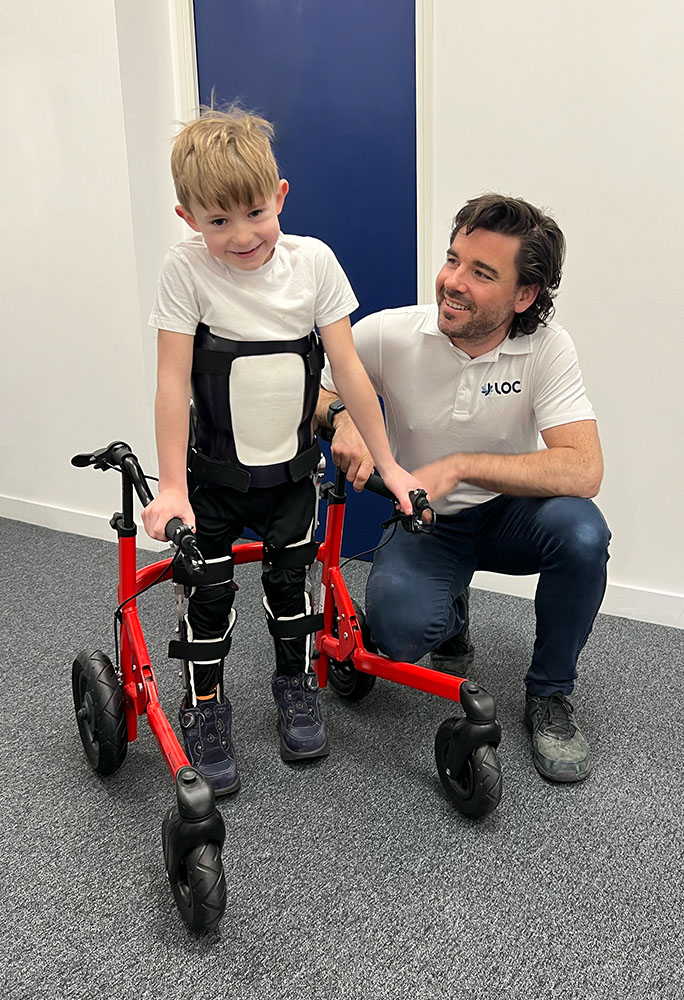A Reciprocating Gait Orthosis (RGO) is a type of orthopaedic device used to aid individuals with mobility impairments, particularly those with lower limb weaknesses or paralysis. The primary purpose of an RGO is to help a patient to walk by providing support to achieve a reciprocal gait pattern.
The device typically consists of jointed metal frames, straps, and other components that attach to the user's legs and torso. The key feature of an RGO is its ability to mimic the natural walking motion. It allows for a reciprocating gait, meaning that as one leg moves forward, the other leg simultaneously moves backward, creating a more natural walking pattern.
RGOs include hinges at the hip and knee joints, allowing for a more dynamic and coordinated movement. They also incorporate a locking mechanism, providing stability during standing or resting phases.
The user usually initiates the movement by shifting their weight or using assistive devices. The RGO then translates this motion into a coordinated walking pattern, supporting the user's legs and facilitating a more independent and functional gait.


Reciprocating Gait Orthoses (RGOs) are commonly used for individuals with mobility impairments or paralysis in the lower limbs due to various medical conditions.
Some of the conditions for which RGOs may be prescribed include:
1. Spinal Cord Injury (SCI): RGOs are often recommended for individuals with spinal cord injuries, particularly those with incomplete injuries who have some residual mobility.
2. Cerebral Palsy: People with cerebral palsy, a group of neurological disorders affecting movement and coordination, may benefit from RGOs to assist with walking.
3. Spina Bifida: Individuals with spina bifida, a congenital condition where the spinal column does not close completely, may use RGOs to support ambulation.
4. Stroke (Hemiplegia): For individuals who have experienced a stroke and have weakness or paralysis on one side of the body (hemiplegia), RGOs can provide support for walking.
5. Guillain-Barré Syndrome: RGOs may be considered for individuals recovering from Guillain-Barré Syndrome, a condition that affects the peripheral nervous system.
6. Muscular Dystrophy: Some forms of muscular dystrophy, which are progressive muscle-wasting conditions, may lead to the use of RGOs to maintain mobility.
7. Traumatic Brain Injury (TBI): Depending on the extent and location of the injury, individuals with traumatic brain injuries may use RGOs to assist with walking.
It's important to note that the suitability of RGOs depends on the individual's specific condition, functional abilities, and rehabilitation goals.
A thorough assessment by healthcare professionals, such as orthotists and physiotherapists, is necessary to determine the most appropriate assistive device for each patient.
At LOC, we specialise in the use of RGOs. Our clinical team is experienced in the assessment and fitting of these complex orthoses. We manufacture the devices in our Kingston clinic, giving us excellent control and the ability to provide the best possible care.
RGOs typically require plaster of Paris casting. However, our clinical team has developed a 3D scanning process so that casting is not required thus reducing any stress and discomfort. We have also designed the orthosis within our Computer Aided Design (CAD) programme. This improves the alignment and fitting process and produces a better orthosis.
Once fitted, the RGO will require maintenance and optimisation throughout its life. LOC has on-site teams to service it, and we use our video vector gait laboratory to continuously optimise the alignment to ensure that our patient’s rehabilitation continues to progress.

Nine-year-old patient Ted with his bespoke Reciprocating Gait Orthosis and his walker with LOC Director Sam Walmsley, who made it for him.
We have the following facilities and amenities at our Kingston Upon Thames location:
We also have the Gait Laboratory for orthotics patients and Onsite Manufacturing for speedy turnarounds and adjustments whilst you wait.
An insole is a contoured orthotic device which alters the characteristics and biomechanics of the foot and ankle area. Biomechanics are concerned with mechanical laws and how they affect the living body, especially the musculoskeletal system.
They are removable devices, often made from plastic, that are designed to fit inside a shoe to provide additional support for your feet. As well as offering shock absorption, an insole can help distribute the weight of your body more effectively across the foot and can be made bespoke to cover a range of biomechanical conditions.
If you have symptoms in your feet, ankles, hips or your lower back that are intermittent or were not there to start with in early life, and have started to cause you pain over a period of time, bespoke orthotic insoles could be an excellent option.
If you have already tried rest, icing, compression and elevation and your feet have not recovered, we recommend a biomechanical assessment to consider the possibility of insoles. They are a non-invasive approach to treatment and in many cases, are a great option for symptoms that are not severe enough to warrant surgical intervention. Alternatively, they can be considered as an option prior to surgery.
We will send patients away when an insole is not appropriate, if a patient is suffering with iliotibial band syndrome for example, the problem can be helped with physiotherapy and a stretching programme. That’s what our biomechanical assessment is all about; determining whether there would be any benefit from altering the alignment of your feet.

Join The London Orthotic Consultancy in celebrating Cerebral Palsy Awareness Day on March 25th. Learn just how important expert orthotic care is in enhancing mobility, independence, and quality of life for children and adults with cerebral palsy.

Introducing the Agilik™ smart orthosis, a cutting-edge, powered knee orthotic now available in the UK through the London Orthotic Consultancy. Unlike traditional KAFOs or heavy exoskeletons, the Agilik™ provides dynamic knee assistance and offers real-time support, reducing fatigue and improving posture. This pioneering, modern technology can help children and adults with lower limb weakness walk more efficiently and naturally. We are honoured to be selected as the exclusive paediatric specialist centre in the UK for the Agilik™ device.

When Sophie noticed her baby Max had a persistent flat spot on his head, she was told it would resolve naturally—but it didn’t. Seeking a second opinion led her to the London Orthotic Consultancy, where Max was diagnosed with severe plagiocephaly.

A little more than four years after the LOCband Lite's launch, we're proud to have successfully treated our 250th helmet therapy patient at our Romford clinic using our cutting-edge 3D-printed cranial band. After five months of treatment, her final scan showed that her asymmetry had decreased from 12 mm to 3 mm.

Sky News published an article this month quoting scientists at Southmead Hospital who claimed there was a lack of research into flat head syndrome and its treatment with cranial remoulding (helmet) therapy. This is our response.

With our non-surgical treatment plan, Alex achieved 100% chest correction in just two years. His treatment involved a combination of dynamic chest compressor and vacuum bell therapy treatment to address his pectus excavatum and rib flaring.

Learn how a custom carbon fibre AFO helped Gill regain mobility and comfort despite complex challenges from shin bone (tibia) removal. We created a truly tailored orthotic solution made from pre-preg carbon fibre at our Cambridge clinic.

Discover how bespoke orthotics and the OSKAR program with Elaine Owen transformed Archie’s life with cerebral palsy quadriplegia, helping him avoid a wheelchair and achieve greater mobility.